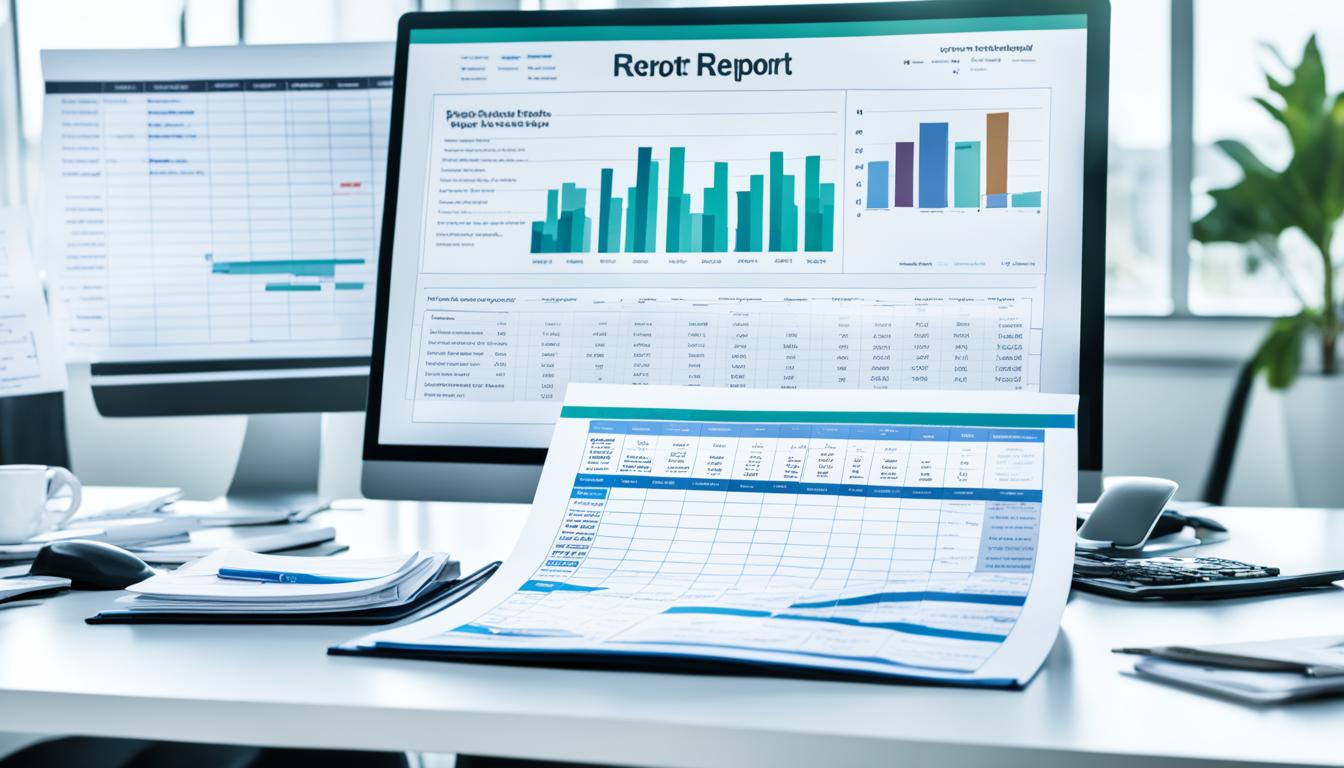A Weekly Progress Report is key for sharing what we did, what we faced, and what we plan to do next. It shows what we’ve done, what we’re facing now, and what we aim to do later. If these reports are not done right, they can cause confusion, missed chances, and poor planning.
To fix these problems, both bosses and workers need to see how vital this report is. It helps make smart choices and share tasks well. Tools like weekly report templates from Visme make reporting easier. They make sure we share all important info, like what we did, what we did it for, and what we plan to do next.

Key Takeaways
- Weekly progress reports are crucial for effective project tracking and decision-making.
- Common mistakes include inconsistent objective formatting, lack of context, and poor organization.
- Using updates templates can streamline the reporting process and enhance clarity.
- Efficient reporting strategies involve balancing high-level perspectives with detailed information.
- Adopting workflows and data visualization tools can improve the presentation of the report.
Not Being Clear and Concise
Weekly progress reports need to be clear and brief to avoid confusion. This ensures the message is strong and clear. If reports are unclear, it can lead to wrong ideas about how well employees are doing. It is important to explain complex information in simple language to ensure clarity.
Keeping weekly reports helps employees track their work all year. It’s like a journal of their progress. Regularly assess the clarity and effectiveness of these reports to ensure they are understandable and accurately reflect project milestones.

The Importance of Clarity
Weekly reports make time for thinking and planning, which boosts productivity. Being clear in reports helps everyone see what’s going on. It also shows where things need to get better or where help is needed.
It’s good to keep the report’s highlights and low points to just 3 to 5 main points. This keeps things focused and clear.
Using Simple Language
A weekly report should be to the point, avoiding complex templates. Using simple words helps show the quick results of what’s being done. This makes the report easy to understand, letting people quickly see what needs to be done.
Overloading With Information
Managers and teams often struggle with Weekly Progress Reports that have too much information. Ensuring that reports contain all the information necessary without being overwhelming is crucial. Too many details can hide what’s really important. It’s key to balance being detailed and brief. Focus on the main tasks and achievements, not the small stuff. Regular status updates are essential for effective project management and communication.
Writing progress reports is a crucial aspect of project management. These reports help monitor project status, enable reflection and improvement in future projects, and ensure adherence to protocols.

Research shows that 80% of workers worldwide feel overwhelmed at work. This feeling of information overload makes 76% more stressed. In fact, 35% say it hurts their work performance, and 30% say it makes them less happy at their jobs. Reports that just update on status without giving useful advice add to this problem. Including only the necessary information helps avoid information overload.
The quality of these reports depends on the info they use. This means we need to work smarter, not harder.
Managers at different levels look at different things when planning. This can make their goals seem too high because they compare to past times. Also, wrong data can mess up things like meeting schedules, stock levels, and how long suppliers take to deliver.
Using brief updates and templates from tools like Visme can help. These tools make sure info is clear and don’t overwhelm people with too much. Also, reports should focus on what actions to take and the most important tasks to fight information overload.
- Prioritizing Tasks: Managers should focus on the most important tasks only.
- Setting Time Limits: Giving a specific time for gathering info keeps things focused.
- Promoting In-Person Interactions: Talking face-to-face helps clear up any confusion.
- Delegating Information Gathering: Giving this job to younger staff can make reports easier to manage.
- Streamlining Communication Processes: Better communication means less unnecessary info.
By tackling information overload with these steps, we can make better decisions and work better. This leads to a more focused and productive workplace.
Neglecting to Track Challenges and Solutions
Weekly progress reports are key for managing projects well. They help projects stay on schedule and stop problems early. But, these reports need to track challenges and offer solutions through effective monitoring. This way, teams can solve problems together. It is also crucial to determine the effectiveness of these solutions based on the data collected.

Identifying Roadblocks
Spotting roadblocks is a big part of progress reports. It means finding what stops progress. Teams can then work together to beat these obstacles.
This helps avoid big problems before they start. It makes work better and more united.
Reports are vital for stopping problems early. They use templates like those in this guide on progress reports. This makes tracking challenges easier.
Reporting Solutions
It’s just as important to report solutions. This means not just finding problems but also offering ways to fix them. The PPP method helps a lot here, focusing on progress, plans, and problems.
Templates from here help track challenges and solutions. This keeps progress clear and helps use resources well.
Using automated tools can also help a lot. Tools like ScrumGenius make reporting easier and keep info quality high. This makes tracking challenges and solutions key to weekly reports, helping projects succeed.
For more on making great reports, check out this resource. Focusing on finding and solving roadblocks is key to project success.
Lack of Consistency in Reporting Format
Reports that change often make it hard to see progress over time. Many groups stick with old ways of reporting without changing. This leads to reports that don’t show new or important info.
Reports with info not used for decisions waste time. To fix this, making reporting format consistency a top priority is key. Using standard templates helps everyone see how things are changing better.

Groups are moving to flexible ways of managing performance, like changing how they report. This change shows why having a strong plan for reporting is vital.
Here’s how different reports stack up in usefulness:
Report TypeEffective Information UsageDecision-Making SupportDashboardsHighStrongScorecardsModerateModerateTrackersLowWeakProgress ReportsHighStrong
Having report uniformity makes it easier to understand and compare reports. This helps spot trends and make better decisions. Changing how reports work needs support from leaders and everyone involved. Working together helps everyone aim for the same goals, making things more efficient.
Failing to Include Future Plans
Not planning for the future is a big mistake in weekly reports. Talking about future plans helps the team know what to do next. Having clear goals and a plan for the future makes the project better by keeping everyone motivated and focused. Additionally, planning for the following week ensures continuous progress and helps prioritize tasks effectively.

Setting Clear Goals
It’s key to set goals in progress reports. This gives direction and sets what the team should aim for. Clear goals make sure everyone knows the future goals and what success means.
Over 90% of companies use project reports to share progress. This shows how important clear goals are.
Planning Next Steps
Planning what to do next is vital in reporting progress. Reports help avoid confusion about what’s done and what’s left. This makes things clear and cuts down on unnecessary work.
It’s good to use templates that separate what’s done from what’s coming. This helps keep things clear. For more tips on good progress reports, check out this resource.
Adding steps to take in reports makes it easy to see where teamwork is needed. This stops work from being done alone and helps meet deadlines. A well-made report shows where the project is now and what’s next.
Using templates like these examples helps make reports balanced and forward-looking.
These practices make reports useful, showing if tasks are done or if there are issues. Adding future plans to regular reports helps make the project more visible and coordinated. This increases the chance of success. Reports with future plans help manage the project now and improve it over time.
Ignoring the Audience’s Needs
Understanding the audience is key to making good Weekly Progress Reports. It’s important to know what they care about, their level of knowledge, and what they need. Customizing reports to meet the specific needs of the audience ensures they are read and understood. Reports that don’t consider these things might not be read or understood.
To make sure reports are useful, they should be made for the specific audience. This could be managers, certain departments, or the whole organization. Prompting the audience to respond to the reports can ensure engagement and collaboration.
- Delivery Strategy: Send reports through trusted channels to make sure people can get them and pay attention.
- Setting Expectations: Tell stakeholders what they will find in each report.
- Accuracy of Source Data: Use exact data to keep trust and be open.
- Clear Measurements: Show clear metrics like budget, schedule, quality, and customer satisfaction for a full project view.
- Relevant Content: Make the content interesting and easy for the audience to understand.
- Timely Availability: Make sure reports come out on time. People need the latest info to make good choices.
- Visual Aids: Use charts and graphs to help people understand complex data better.
By keeping these points in mind, reports can become powerful ways to communicate. Each report should aim to add value, help with growth, and keep stakeholders involved.
Let’s look at some common issues with stakeholders in reporting:
Stakeholder ChallengeImpactSolutionThe DenierWon’t accept negative reportsHighlight learning and growth chancesShoot the MessengerBlame the reporterFocus on true and clear dataHomework MarkerToo critical of report detailsGive clear, simple insights and visual aidsFeed the BeastWants too much detailKeep details balanced with clear and relevant information
Customizing how you communicate is key to beating these challenges. By making reports for specific people, stakeholders stay interested and can make better decisions. Using tools like Visme’s AI Document Generator can help make reports even better, making sure they meet the audience’s needs.
Using Vague Language
An effective weekly progress report needs specific language to avoid confusion. Using measurable results sets clear goals and gets real results.

Being Specific and Measurable
Reports that are vague don’t give clear guidance or useful information. Being specific and measurable makes it clear what’s done and what’s left. For example, saying “Task A by 10%” is better than “some progress on Task A”.
Studies show that asking for specific answers in reports can improve tracking by 25%. Using charts and data makes it easier to see what’s done well and what’s not.
Providing Concrete Feedback
Concrete feedback is key for better understanding. General comments get lost, but concrete feedback points out what needs work. This leads to clear results and plans.
Teams that get concrete feedback feel 20% more motivated. They feel responsible and compete in a healthy way. Good feedback also helps plan better, making teams and projects work better.
BenefitPercentage IncreaseReduction in duplicated efforts30%Effective communication through visuals43%Accurate tracking with KPIs25%Time saved with asynchronous communication15%Team motivation20%Project success rate through transparency10%Improvement in project efficiency15%Future planning effectiveness18%
Not Addressing Employee Performance
Weekly Progress Reports give team members credit for their work and highlight what they have achieved, showing how close tasks are to completion and where they can grow. Not saying thanks or pointing out what needs work can make people feel unmotivated. It can also stop them from getting better at their jobs.

By saying what’s done well and what needs work, you help people grow. Identifying areas for improvement based on performance data is crucial. This helps the whole team do better.
Recognizing Achievements
Recognizing achievements is key in reviews. Saying thanks to employees makes them feel good and want to do more. It keeps the quality of work up and stops people from feeling down.
It also stops people from feeling left out or upset with each other. This can lead to problems like not wanting to work together.
Highlighting Areas for Improvement
It’s just as important to talk about how to do better. We look for areas where people are not doing well. Things like not having the right skills or not knowing what’s expected can be issues.
Helping people with training or a mentor can make a big difference. Talking often and giving clear feedback helps set goals and manage workloads. It makes sure everyone knows what they’re supposed to do.
Regular, helpful feedback can really boost how engaged and motivated employees are. Gallup found that weekly feedback makes people more engaged and more likely to feel like they get useful feedback. Using tools like Visme’s template makes it easier to give feedback. This way, you can praise what’s done well and suggest how to improve.
Failing to Create Alignment between Teams
After the pandemic, 65% of workers felt less connected to their coworkers. This led to big problems with team alignment and working together across departments. Without alignment, different teams may not work well together. This slows down reaching the company’s goals and hinders the project’s progress. It is crucial to address any misalignments to ensure effective collaboration.
Using tools like Objectives and Key Results (OKRs) helps track success. It makes sure teams work towards big goals set by leaders. Also, working together and sharing ideas helps align teams around the “Jobs to Be Done” framework.
Making priorities clear is key to making a big impact and adding value to customers. When teams know what’s important, they stay on track, meet deadlines, and build trust.
An alignment workshop brings team members together to focus on goals. It encourages honest feedback. This way, everyone’s ideas are heard, making it easier to support team decisions.
Survey/Research SourceKey FindingsGartner77% of executives feel part of something important at their organization, but only 59% of employees feel the same.Researchscape47% of workers believe projects fail due to misalignment, and 46% express frustration as a result.Forrester Consulting79% of decision-makers say cross-functional collaboration is a challenge due to siloed workflows.Project.co65% of people often experience difficulty finding the files they need, and 41% struggle to get an overview of a project’s status.LSA Research33% of low-alignment organizations have unsatisfied customers, while 96% of high-alignment ones have satisfied customers.MIT Sloan Management ReviewOnly 28% of executives and middle managers responsible for strategy could list their company’s strategic priorities.
Working together across departments can be tough, with 79% of leaders saying it’s hard because of silos. But, the benefits are big. Teams that work well together make 58% more revenue and are 72% more profitable. They also have happier employees.
Not Adapting the Weekly Progress Report to the Company’s Needs
To make your weekly progress reports work better, you must develop them to create customized reports for your company’s needs. Standard reports often leave out key details important for your business. By customizing reports, you make sure they match your company’s goals and values. Tailoring these reports to meet your company’s specific needs enhances communication and effectiveness.
Customizing Your Report Format
Changing your report format can really help your company track progress better. Tailored weekly reports give a clearer view of how things are going. They are great for planning for the next week and cover more information.
Reflecting Company Goals and Values
Adding your company’s goals and values to weekly reports makes them more engaging and meaningful. This way, teams can connect their work to the company’s big goals. It motivates employees and makes sure progress is clear to everyone.
Ignoring Development Opportunities
Weekly Progress Reports are a great chance to talk about professional development and advance your career. Not using this chance can stop employee growth and new ideas. Adding development plans shows you care about getting better and helping your team grow. Including development initiatives in these reports is crucial for clear communication about project progress and any potential concerns related to its timeline.
This shows you value your team’s work and their future. It’s what Ai Group talks about. They say focusing on development shows you care about your team’s growth.
SAIG group themesDurationSkillstreaming GuideProgress MonitoringClassroom Survival Skills, Emotional Management Skills9 weeksMore than 100 pages of time-tested best practices, grouped for K4-K5, 1-3, 4-5, 6-8Daily, weekly, or mixed, based on grade levelSelf-Care SAIG sessions9 weeks6 youth-driven sessions for middle and high school students1, 2, or 3 ratings on “Be Safe, Be Respectful, and Be Responsible”
Adding growth initiatives regularly keeps employees happy and motivated. It’s smart to have clear plans for skill-building in these reports. This helps everyone grow, making the whole team work better and happier.
Conclusion
Having a strong weekly reporting system is key for better reports and tracking progress in a company. Weekly progress reports are vital. They help align team efforts, increase transparency, and make smarter decisions.
Managers should avoid mistakes like too much info, not tracking challenges, and unclear language. Adding past projects, current tasks, and future plans makes reports clear and useful.
Customizing reports to fit the company’s goals and values makes them more relevant and powerful. Weekly reports are important for sharing progress, solving problems, and keeping the team on the same page. This helps the company succeed and be more productive.
FAQ
What is a Weekly Progress Report?
A Weekly Progress Report is a key tool for progress reporting that shares what was done, what’s hard, and what’s next in a week. It shows past wins, current hurdles, and future goals. This helps in making smart choices and sharing tasks.
Why is clarity important in Weekly Progress Reports?
Clarity stops mix-ups and makes sure info hits the mark. Using simple words and avoiding jargon makes sure key results stand out. This way, important points are clear without getting too complex.
How can I prevent information overload in my reports?
Focus on the most important tasks and wins. Use tools like Visme’s templates to highlight key info. This keeps the report focused and easy to read.
Why should I track challenges and solutions in my report?
Tracking challenges and solutions makes things clear and encourages working together to solve problems. It shows what’s tough and what help is needed to get past it.
How does consistency in report formats help?
Being consistent makes reports easy to understand and compare over time. Standard templates keep things the same, making it simpler for people to see how things are changing or staying the same.
What should be included in future plans within Weekly Progress Reports?
Future plans should have clear goals and steps to take next. This gives a clear path for ongoing progress. It helps guide actions and keeps the team focused and motivated.
How do I tailor my Weekly Progress Report for my audience?
Make the report fit the needs and level of the people reading it, whether they’re managers, departments, or the whole company. This makes sure the info is useful and can be acted on.
What is the impact of using vague language in my reports?
Vague language doesn’t give clear insights or direction. Being specific and clear sets clear goals and makes it easy to see if you’re meeting them. Using clear feedback helps everyone understand better.
Why is addressing employee performance in reports important?
Recognizing wins and areas to improve keeps the team motivated and growing. It shows how everyone and the team are doing and where they can get better.
How does creating alignment between teams within reports benefit organizations?
Alignment means different teams work together towards the same goals, avoiding mixed efforts. A shared reporting platform tracks progress together and helps teams talk smoothly.
How can I adapt the Weekly Progress Report to suit my company’s needs?
Use report formats that match your company’s goals and values. Reports that fit your company better engage employees and stakeholders more deeply, leading to better analysis.
What role do professional development opportunities play in Weekly Progress Reports?
Adding ways for skill-building and growth shows you care about getting better and empowering employees. It creates a culture of learning and new ideas in the company.

More Posts
10 Productivity Management Techniques for Busy Professionals
Welcome to the fast lane, busy professionals! Juggling tasks, deadlines, and meetings can be overwhelming. Fear not! Our “10 Productivity Management Techniques” blog is your lifesaver. Discover game-changing strategies to streamline your workday,...
10 Best Online Calendar Planners for Personal & Professional Use
Are you struggling with managing your finances and keeping up with the numerous bills, expenses, savings goals, and debt repayments? You’re not alone! The good news is that an online monthly budgeting planner...
7 Productivity Experts to Follow on Social Media
In our digital age, more than 60% of people use social media. Facebook, Instagram, and TikTok are now key for productivity tips. Many of us struggle to balance work and life. But, some...
How to Write an Effective Vision & Mission Statement?
A compelling vision and mission statement makes a huge difference for your productivity and decision-making. Learn how to write them the best way!